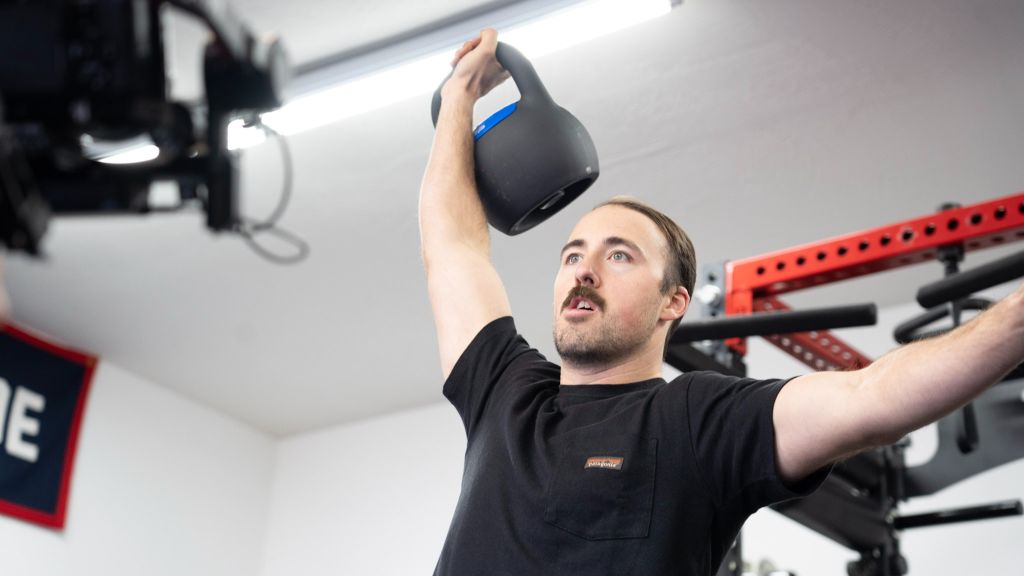We test and review fitness products based on an independent, multi-point methodology. If you use our links to purchase something, we may earn a commission. Read our disclosures.
The kettlebell, although simple in its design—it’s just a handle attached to a weighted ball—is a versatile piece of workout equipment that can build strength, power, endurance, and increased mobility through proper training.
A full-body kettlebell workout is one of the most effective ways to build overall fitness. The best part is you can get through an entire workout only needing one piece of equipment. In addition to traditional kettlebells, which are solid throughout and come in many different weights, there are also adjustable kettlebells that will allow you to change the internal weight but maintain the same function.
Using kettlebells requires proper form. This enables you to move with strength and power efficiently as well as receive all of its benefits. With the right coaching, it’s possible to learn good form and perform kettlebell exercises at home. And you’re in luck, because I’m a certified personal trainer and USA Weightlifting Level 1 Trainer who coaches clients on kettlebells frequently—let’s dive into what you need to know.
My Favorite Kettlebell Exercises
You can perform a myriad of exercises with kettlebells, but here are a few of my favorites.
Kettlebell Swings
The keys to a proper kettlebell swing are to perform a hip hinge, utilize the leg drive of the lower body, and keep a tight core. If you do these three things, the kettlebell will swing fluidly and its momentum will carry you through the set.
How to do it:
- Start by holding onto the handle with both hands in front with arms straight. The arms will remain straight throughout the entire exercise. You will also maintain good posture throughout the exercise by keeping the shoulders back and chest out. Make sure your legs are at least shoulder-width apart so that there is room for the kettlebell to go between them.
- Now, lower the kettlebell and reach it slightly back through your legs by pushing your hips back with a slight bend in the knees.The back will remain straight the whole time. Once your arms are just about touching the thighs you are ready to swing the kettlebell.
- Aggressively extend the legs and hips together and let your arms guide the momentum of the kettlebell to shoulder height. Guide the momentum back down reversing the motion of the swing in order to load into the next rep with the kettlebell between the legs and hips.
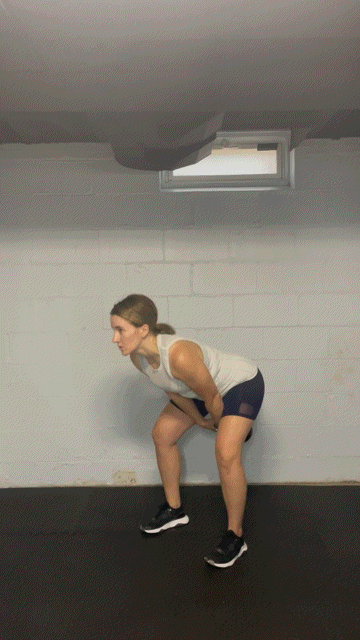
The lower body should be doing almost all the work, and the arms are mostly there to guide the kettlebell. Once again, make sure to maintain good posture the entire time in order to protect the lower back.
Sets and reps: Three sets of 20 reps
Weight to use: For people who can deadlift at least their own bodyweight, somewhere between 25 and 35 pounds is a good starting place. If this weight feels very heavy just picking it up off the ground, then start with the lightest option available and work your way up to a weight that challenges you to keep it moving the entire 20 reps with good form.
Kettlebell Deadlift
The kettlebell deadlift is one of the best exercises for developing strength in the posterior chain. The most important part of the deadlift is to make sure that the legs are actively working to lift the weight and doing the majority of the work. If it feels as though the lower back muscles are being overworked, then it most likely means the legs and core are not engaged enough.
How to do it:
- Start with your feet shoulder-width apart and the kettlebell directly between them. Grab onto the handle with both hands. Once you have a hold of the kettlebell, use it to pull your hips and back into place. In the starting position your hips will be just higher than your knees and your back will be at about a 45-degree angle with shoulder blades pulled back and looking straight forward.
- Before you begin to lift the kettlebell, tighten up the core as if someone was about to punch your stomach.
- Then, keep your arms locked and think about pushing the ground away from you with your legs. As you do this the shoulders and hips should raise at the same time.
- When the kettlebell reaches knee height, think about bringing the hips forward and squeezing your butt to extend the hips to a fully standing position.
- To lower the kettlebell back down, keep posture through the shoulders and push the hips backwards. Once the kettlebell is past the knees, lower your butt down to bring it to the ground.
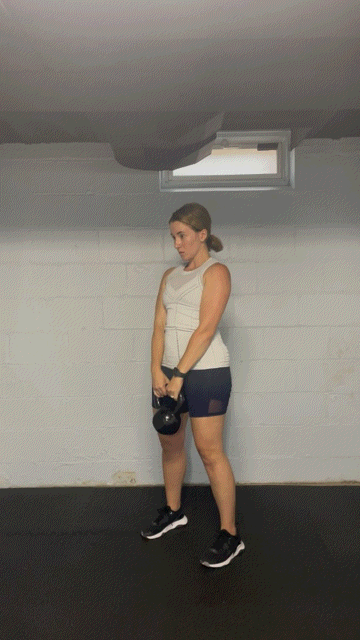
Maintain good posture and a straight back throughout the exercise. You should mainly feel the glutes and hamstrings during the lift as well as the upper back from maintaining posture.
Sets and reps: Four sets of 12 reps
Weight to use: For people who are well-conditioned, I recommend a kettlebell between 35 and 55 pounds. For those new to lifting free weights, start with the lightest kettlebell available and gradually work your way up as long as you can maintain good form.
Kettlebell Renegade Row
The kettlebell renegade row is a much more advanced version of the kettlebell row. It will put increased pressure on the core and challenge the body’s ability to balance as the kettlebells will be unstable.
How to do it:
- This exercise starts in a push-up or high plank position with the hands on the kettlebells. The body should remain straight from the head to the legs in this position throughout every rep.
- Begin to row one kettlebell up, pulling the elbow into your side and squeezing the lat muscle at the top.
- Lower the kettlebell down in a controlled manner and repeat on the other side. The key is to only move the arms with each row. The body will want to shift and use other muscles to help lift the kettlebell, but try to resist any movement other than the arm pulling the kettlebell up.
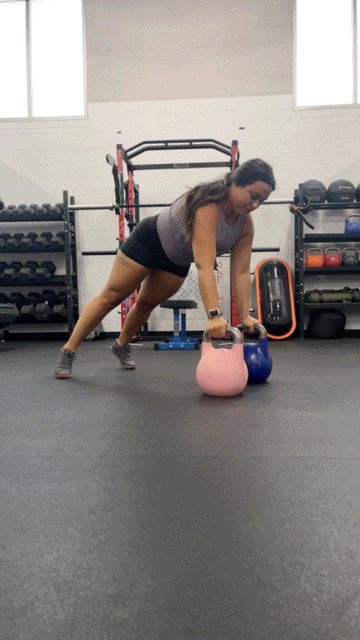
Sets and reps: Three sets of 10 reps on each arm
Weight to use: You will want to use a weight lighter than what you typically use to row in order to keep strict form. If you aren’t sure, start with between 10 and 20 pounds and increase on each set if the set prior feels too easy.
Kettlebell Turkish Get-Up
The Turkish get-up is a very technical exercise that has many steps. It will require more practice than the other exercises in order to master the form.
How to do it:
- You will start lying on your back with the kettlebell in your right hand and the right arm extended straight upwards. The left arm will be extended straight out to the side on the ground, the left leg extended and the right knee bent with foot on the ground.
- Push through the right foot and come up onto your left elbow, continuing to push the kettlebell upwards.
- Now push into the ground with that left hand, and while keeping pressure through the right foot and left hand, raise the hips off of the ground and bring your left leg under you in order to rest in a half-kneeling position on the left knee. The kettlebell is continuing to be pushed upward and you have three points of contact with the ground: the right foot, left knee, and left hand.
- Now sit up tall in the half-kneeling position so that the left hand comes off the ground and the kettlebell is now in the overhead position. Swing your left foot so that it is facing the same direction as the right foot.
- Now stand up, pushing through the right heel and bringing the hips through at the top.
- Follow those steps in reverse to get back down, starting with stepping back into a lunge to return to a half-kneeling position. The rep is completed when you return to the starting position on the ground.
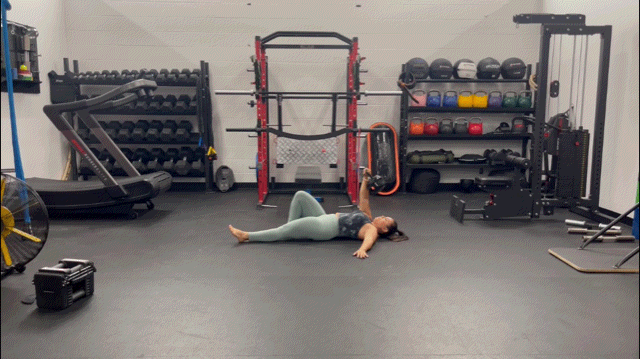
Sets and reps: Three sets of 5 reps each side
Weight to use: If this is your first time performing a Turkish get-up, you will want to start very light until you feel comfortable with the technique. Start with no more than 10 to 15 pounds for beginners.
Kettlebell Thruster
The thruster is a great exercise to build lower-body power in the glutes and quads while also fatiguing the shoulders and triceps. It combines a squat with an overhead press to create a full-body exercise.
How to do it:
- Hold the kettlebell in a front rack position with one arm. The front rack position holds the kettlebell at the shoulder with the elbow up and the bell resting against the forearm.
- Start by performing a squat with the kettlebell in the front rack position. Keep the chest up, push the hips back and down until below parallel.
- Then stand up out of the squat explosively, using the momentum from the legs to transfer into pressing the kettlebell overhead until the arm is locked out.
- Lower the kettlebell back down to the front rack and immediately go into the squat of the next rep.
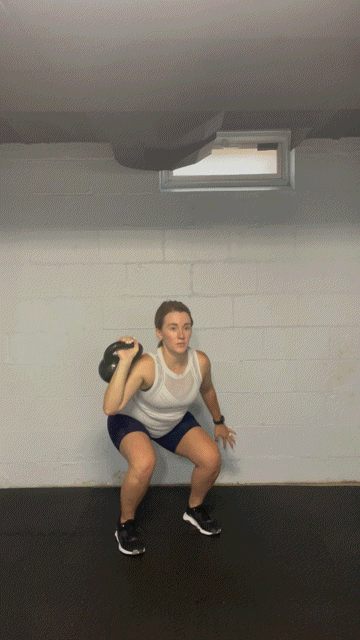
Sets and reps: Four sets of 10 reps
Weight to use: Use a weight that is 5 to 10 pounds less than you can overhead press for the same amount of reps. The focus here is controlled squats and then speed coming out of the bottom to that lockout position at the top.
Workouts
Below, I’ve created three workouts utilizing my favorite kettlebell exercises that you can do in your home gym. Choose the one that best fits your goal, and get after it!
Tabata-Style
This is perfect if you’re looking for a short, simple, and effective workout that will get your heart rate up and challenge the whole body.
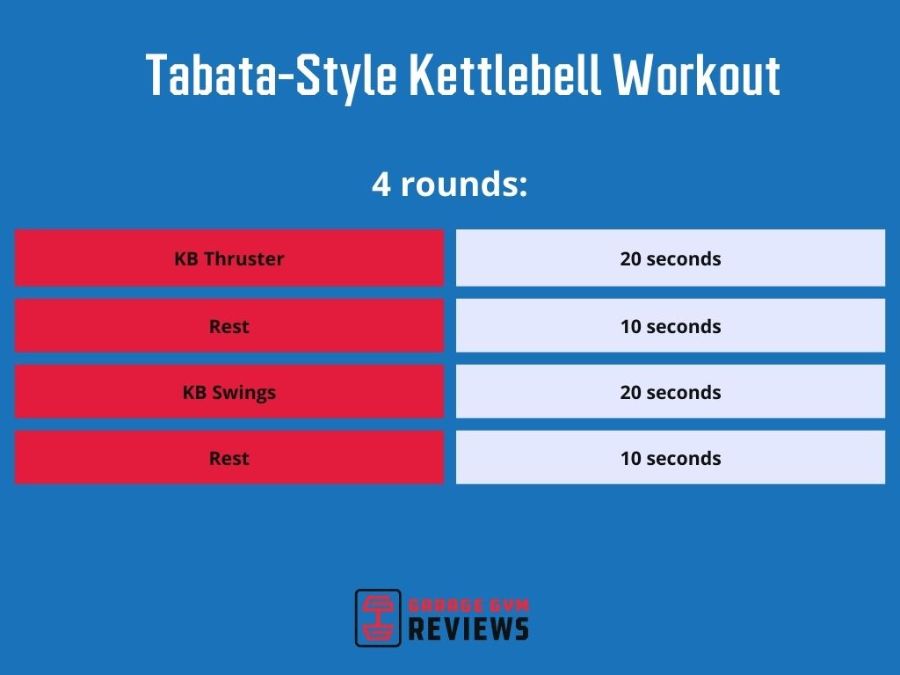
Alternate between 20 seconds on and 10 seconds of rest for 4 minutes between the kettlebell thruster and the kettlebell swing. This will give you eight total rounds in the workout with four each for the kettlebell swing and thruster. You should be working the entire 20 seconds in order to maximize the amount of reps performed.
4 rounds of:
20 seconds max reps thrusters
10 seconds rest
20 seconds max reps swings
10 seconds rest
Strength
If you want to focus solely on building strength with the kettlebell, it would be best to perform all the sets and reps of one exercise before moving onto the next one with programmed rest in between. This will help to promote maximal force production with each rep without fatiguing the cardiovascular system. Here is a good workout using the kettlebell and bodyweight movements to promote full-body strength:
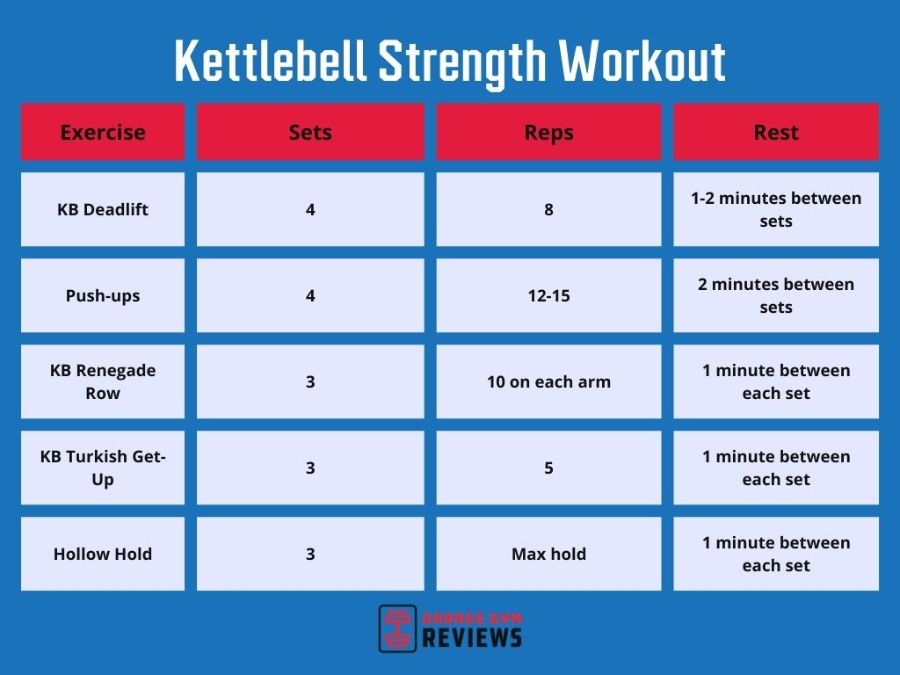
Kettlebell Deadlifts
Four sets of eight reps for max weight. If limited with the amount of weight you are able to use, then lower the kettlebell down to the ground slowly for 3 to 4 seconds each rep. Rest for 1 to 2 minutes between sets.
Push-ups
Four sets of 12 to 15 with 3 to 4 seconds lowering to the ground, 1-second pause at the bottom, and an explosive press to the top. Rest 2 minutes between sets
Renegade Rows
Three sets of 10 reps on each arm, alternating. Take your time and perform as strictly as possible. Rest 1 minute between each set.
Turkish Get-Ups
Three sets of 5 reps on each side for quality of movement. Rest 1 minute in between sets.
Hollow Hold
Lie on your back with arms and legs off the ground and abs fully contracted. Complete three sets for max time. Rest 1 minute between each set.
HIIT
This will be longer and more intense than the Tabata and aim to burn as many calories as possible in a short period of time while building muscular endurance. During the 3 minutes of work, you’ll try to get through the set of exercises as many times as possible before the rest period. The goal in the workout will be to try and get as many reps as possible (AMRAP) in each separate round. You will find yourself becoming more fatigued as the workout goes on, making it difficult to achieve as many reps as you were able to in the first round.
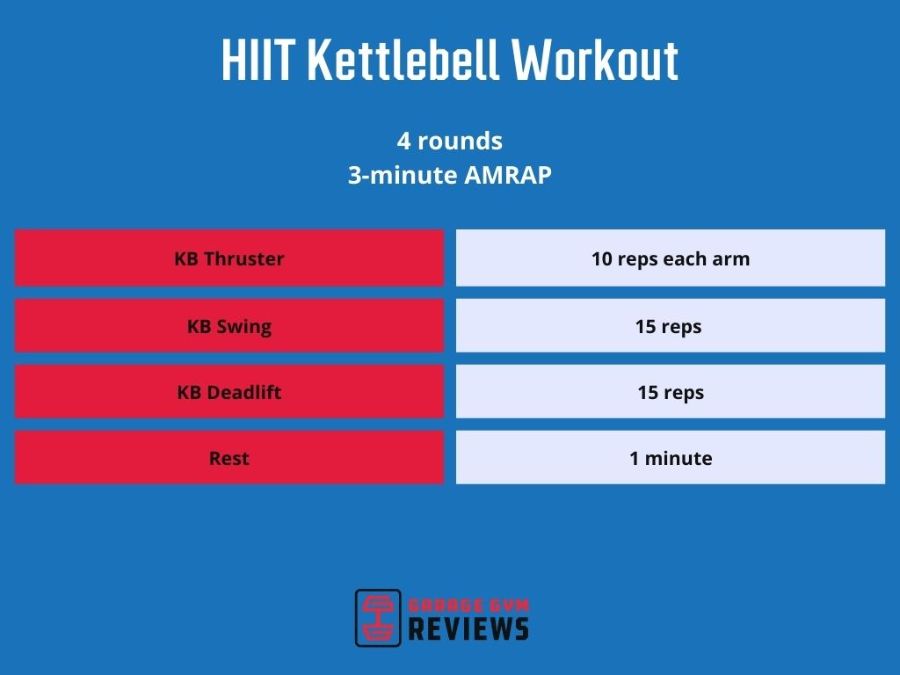
Four rounds of:
3-minute AMRAP
Kettlbell thruster: 10 reps each arm
Kettlebell swing: 15 reps
Kettlebell deadlift: 15 reps
1-minute rest
Benefits of Training with a Kettlebell
Kettlebells have advantages over other free weights like dumbbells and barbells. Kettlebell benefits include:
Versatility
The kettlebell is one of the most versatile pieces of training equipment. Beyond being compact—perfect for home gyms—its design makes it easy to seamlessly transition from one exercise to the next without needing to let go of the handle. The list of exercises able to be done with a kettlebell would be extensive.
Kettlebells add variety to any exercise just based on how you hold them as well. You can hold it in front, on the shoulder, down at your side, or even overhead to change the stimulus of a squat, lunge, or carry. Kettlebell full-body workouts are a great way to keep the body guessing with their variety of strength training movements.
Increased Grip Strength
It’s almost impossible not to work your grip and forearms when doing kettlebell exercises. The standard kettlebell handle is thicker than what you will find on most dumbbells or on a barbell. This thickness will challenge the muscles that are involved with grip strength, which will cause them to become stronger because it is harder to hold onto and will fatigue those muscles quicker.
Just holding a kettlebell at your side while doing a lunge will be more difficult than using dumbbells. You could also do exercises specifically to challenge the grip, such as a farmer’s carry in which you walk for a distance with a challenging weight. Having a kettlebell in each hand will help build the grip of the left hand and right hand separately as opposed to a barbell.
Increased Muscular Strength
The added benefit of kettlebell exercises for building strength is that they will challenge the core to stabilize the whole body. With a dumbbell, the weight is evenly distributed on either end of the handle; a barbell is similar. A kettlebell has all the weight hanging from its handle creating more variability as you move the kettlebell through an exercise.
While this is happening, smaller stabilizer muscles throughout the body have to engage in order to maintain balance and proper form. The increased recruitment of muscle helps to improve the development of strength throughout the entire body.
Better Range of Motion
Kettlebells can be used to target many different movement patterns. Range of motion improves as the body gets used to and comfortable with more movement. Deeper stabilizing muscles that are trained when moving a kettlebell around help to open up bigger ranges of motion by keeping the rest of the body steady.
For example, when using a kettlebell with the right hand, the left obliques will have to stabilize the midsection. The stronger the obliques become it allows the right hand to move the kettlebell farther away from the body without losing balance.
Better Form
Keeping a kettlebell balanced throughout an exercise requires more precise form than with a dumbbell. One slight deviation may throw off the balance of the rest of the body. For the more power-based movements, good form is required for efficiency with movement to limit fatigue and direct the power in the right direction.
Best Kettlebells for Full-Body Workouts
Kettlebells fall into two main categories: traditional kettlebells and adjustable kettlebells. Here are my favorites.
Best Traditional Kettlebell
The best traditional kettlebells on the market are the Rogue E-Coat Kettlebells. These kettlebells come at a good price and a wide range of weights. The E-coat is extremely durable and resistant to chipping, scratching, or rusting.
Best Adjustable Kettlebell
The best adjustable kettlebell is the REP Fitness 24kg Adjustable Kettlebell. It’s shaped just like a traditional kettlebell, unlike many other adjustable ones on the market. They are durable and make it easy to change the weights out. It goes all the way up to 24 kilograms (53 pounds), which is pretty heavy for an adjustable kettlebell.
Final Thoughts on Full-Body Kettlebell Workouts
If I could only use one piece of equipment to improve overall fitness, the kettlebell would be a top choice. It has as many workout benefits as any other piece of free weight equipment and provides a wide variety of exercise and workout options regardless of your current fitness level.
- The kettlebell can help improve strength, cardio and muscular endurance, power, mobility, and help with weight loss.
- Traditional kettlebells come in a wide range of weights, while there are also adjustable ones on the market as well.
- Learning and practicing proper technique may be more difficult than with a dumbbell, but once you learn good form, it will provide more benefits
- Kettlebells are great for full-body workouts because of how easily you can move from one move to the next. Plus, you can use them for compound exercises such as the thruster.
Full-Body Kettlebell Workout Q&A
Can you get a full-body workout with kettlebells?
A kettlebell is one of the best pieces of equipment for a full-body workout. An exercise like the thruster is a great example of a full-body movement that can be performed with a kettlebell. Just about any movement is at your disposal, which will provide the ability to target any muscle group that you desire. Upper-body, lower-body, single-arm, single-leg, you can train all the movement patterns and muscle groups of the body in order to get a full-body workout with just one kettlebell.
Can you do full-body kettlebell workouts every day?
Because of its versatility, a kettlebell will allow you to be able to do a workout every day without doing the exact same movements. That being said, I wouldn’t recommend strength training every day. Ideally, you will want to take at least one or two rest days a week.
Can you get ripped with kettlebells only?
If you only want to use kettlebells, then they will do just as good of a job getting you ripped as any other form of resistance equipment. It will be important to make sure you use a weight that’s challenging enough in order to cause the right adaptations to build muscle. Too light of a kettlebell may still give you a good calorie-burning workout but won’t create enough tension to build muscle needed to have the desired ripped look. Keep in mind, too, that nutrition plays just as important of a role in getting ripped, so ensure you’re eating properly as well.
How heavy of a kettlebell should I get?
The weight that you need will depend on your fitness level, strength, and what types of exercises you plan to use it for. If possible, having a set of kettlebells with a range of weights would be best. I would suggest that men get between a 25-pound and 35-pound kettlebell. For women, between 15 pounds and 25 pounds should work. If you feel confident in your strength and fitness then you may be able to start heavier.
Further reading

Forget the crunches! These rotation and anti-rotation exercises will help you build impressive core strength and stability! Check ‘em out here! Read more

Get your heart pumping and your muscles moving with our trainer-written kettlebell cardio workout. Read more

Workout shoes are an important piece of gear that most invest in for theirhome gym. Unless you’re one of those barefoot folks (which I am often as well). A good pair of shoes—and more importantly, the best pair for you—is the difference between an invigorating workout and a dumpster fire of a training session.That’s why I love reviewing all kinds of workout shoes, from the Nike Free Metcon 4s to theReebok Nano X1s to theNoBull Trainers. In this Reebok Nanoflex TR training shoes review, I divulge all the pros and cons of this Reebok Nano wannabe.Why You Should Trust UsOur team is made up of fitness experts, enthusiasts, and credentialed professionals. We’ve all been wearing training shoes for a long time (collectively, many decades), so we know what to look for in a good pair ofworkout shoes for different activities. Read more

The Marc Pro is a muscle conditioning device that stimulates your muscles to improve their performance and recover from muscle breakdown. Through months of use, we found that we felt more recovered after using the device. However, we do recognize that this could be a placebo effect. Read more

